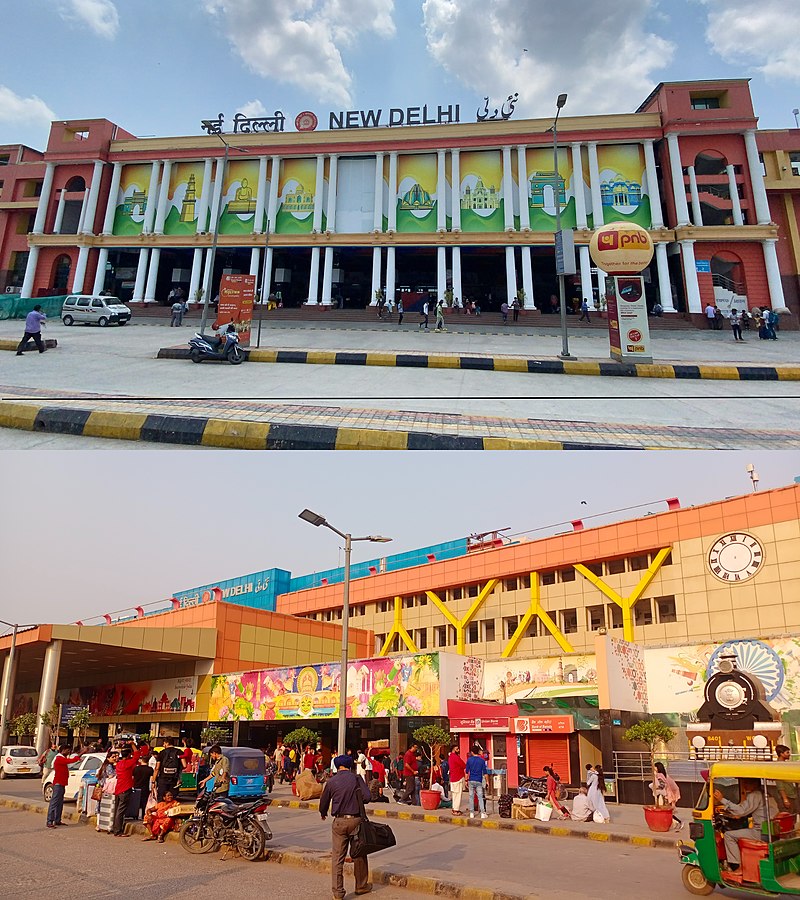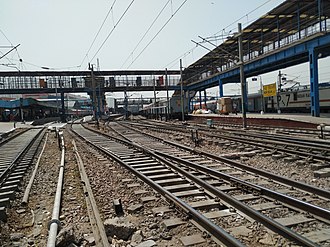Revamp Of New Delhi Railway Station.

History of New Delhi Railway Station
Before the new imperial capital New Delhi was established after 1911, the Old Delhi railway station served the entire city and the Agra–Delhi railway line cut through what is today called Lutyens’ Delhi. The line ran through plans for a new capital.
The railway line was shifted along the river Yamuna and opened in 1924. Minto rail bridge came up at this time. The East Indian Railway Company sanctioned the construction of a single-story building and a single platform between Ajmeri Gate and Paharganj in 1926; this would go on to become the New Delhi railway station. The Viceroy entered the city through the new railway station during the inauguration of New Delhi in 1931. later new structures were added to the railway station and the original building served as the parcel office for many years.
By 1955 a new station building had been constructed at the cost of about ₹20 lakh. A common entrance, exit and circulating area for all classes of passengers were created. It was the first station in India to have common facilities. Up until then an adapted form of the colonial era system had remained in place, the platform and area that had been reserved for the Britishers was used by upper class Indians while the other platforms and areas went to the lower classes. A common area for refreshments was built, waiting areas as per ticket class, and resting rooms with different fees open to all classes. The building layout and design was done under the architect of the Ministry of Railways. The one platform station was officially inaugurated on 16 April 1956. Up until then Old Delhi railway station was the main station.
New Delhi railway station is the main railway station of India. The station is in Central Delhi, about two kilometres north of Connaught Place in New Delhi. Platform 1 is located at Paharganj and platform 16 opens up on to the side of Ajmeri Gate. It is one of the busiest railway stations in the country.
Until the 1950s, the Old Delhi railway station was the main station in Delhi. The official inauguration of the one platform of New Delhi railway station took place in 1956. The station building at Paharganj was the first in India to have common station facilities for all passengers, including a common entry and exit. In the early 70s, there have been continuous efforts over the decades to improve rail traffic and congestion on the platforms. By the 1980s the station had seven platforms, in 1995 it had ten platforms and during the 2010 redevelopment, the platforms increased to sixteen. The new station building on the side of the Ajmeri Gate was upgraded during this redevelopment. Delhi Metro connectivity has been integrated.
All the 16 platforms cater to more than 250 trains that start, end, or pass through the railway station daily. According to different studies, estimate for daily footfall and passenger handling vary over the years. It estimates daily footfall at around 5 lakhs, which can reach 6 lakhs during peak festival season. Since 1999s, the station holds the record for the largest route relay interlocking system in the world.
Rail Traffic

The station is the main junction for the Rajdhani Express and some pairs of Shatabdi Express originate and terminate at this station. In 1969 the first Rajdhani Express left from the station to Howrah. The first Vande Bharat Express was flagged off from the station in 2019. Luxury tourist trains have an itinerary which starts and ends at New Delhi railway station, Palace on Wheels, Royal Rajasthan on Wheels and Maharajas’ Express. The Buddhist circuit train Mahaparinirvan Express also starts and ends at this station. The number of trains per platform per day varies from 13 trains to 23 trains. On average the station handles 250+ trains every day, while the maximum handled in a day reaches 275. It handles around 400+ unique trains in total.
Lines
Rail lines include the New Delhi-Mumbai main line, Howrah-Gaya-Delhi line, both part of the Diamond Quadrilateral, and the New Delhi-Chennai main line, the lines have been improved in various ways over the years and there are plans to further improve it. The maximum sectional speed permissible on these lines in 2016 was 100–130 km/h The Delhi-Ahmedabad high-speed rail corridor, part of a larger modernisation push, was planned.
Daily footfall and passengers
The station handled around 268,000 passengers daily in 2011. Rohit Anand’s study between 2016 and 2018 estimated a daily footfall of 482,000. the study calculated an equivalent passenger unit (EPU) of 4,15,157. During festivals, daily footfall can reach 6 lakhs.
Connectivity

New Delhi railway station is served by New Delhi station on the Yellow Line of the Delhi Metro, and also by the Airport Express (Orange Line), which connects it directly to Indira Gandhi International Airport and further to the Blue Line. A 242 metres (794 ft) skywalk connects the foot over bridges on Ajmeri Gate side of the station to the metro and the parking complex on Bhavbhuti Marg. The total distance of the foot over bridge from Paharganj side to the Bhavbhuti Marg parking area is 442 metres (1,450 ft).
Renovation of New Delhi Railway Station
As per reports, Indian Railways is facing challenges in finding a suitable bidder for Rs 4,700 crore tender for the redevelopment of New Delhi Railway Station (NDLS). To avoid delays, they are likely to divide the tender into smaller ones. This move aims to expedite the bidding process and kickstart the execution of the project. The Railway Land Development Authority (RLDA) has already initiated a separate tender for the design, construction, and commissioning of a multi-modal transit hub on the Paharganj side of the station, requiring an investment of Rs 440 crore.
As per reports the most recent tender for the New Delhi Railway Station (NDLS) redevelopment project was withdrawn in early February due to unresolved issues, including the challenge of constructing a curved road over the tracks. To enhance the efficiency of the redevelopment process for the New Delhi Railway Station (NDLS) project and ensure more accurate valuations, officials are considering dividing the tender into multiple parts and reissuing it in the coming months.
One of the main challenges for the project is the redevelopment of the congested areas of Ajmeri Gate and Paharganj. These two heavily populated localities are located on either side of the station. However, it’s worth noting that all the land required for the project is owned by the government.
Indian Railways possesses a significant piece of land adjacent to the railway station, presently utilised for office space for railway personnel. As per reports, the plan entails constructing new office facilities on-site, following which the existing offices will be razed to accommodate commercial establishments and a pedestrian thoroughfare. Previously, the NDLS redevelopment project faced challenges due to coordination issues among various government departments and multiple authorities in Delhi. However, in the past year, the land authority diligently engaged with over a dozen central and state departments, obtaining No Objection Certificates from them, signalling improved coordination and progress for the project.
New Design Of New Delhi Railway Station –
The redesigned New Delhi station will span an extensive area of 1.5 crore square metres, featuring a pedestrian boulevard linking it to Connaught Place. Revenue generation is envisioned through commercial developments within the premises as part of the project’s strategy.
The revamped New Delhi Railway Station aims to become a multimodal transportation hub, seamlessly connecting the station to the airport and the city. With nearly 5 lakh daily visitors, the station will feature a roof plaza hosting shopping areas and a food court for passenger convenience. Platforms will be exclusively for boarding and alighting trains. Currently linked to the Delhi Metro, the station will undergo phased renovations, with sections closed for up to four months at a time to facilitate the project’s progress.




